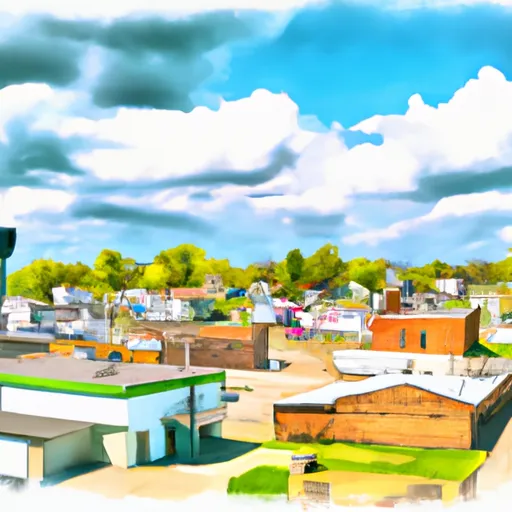-
 Snoflo Premium
Snoflo Premium
Get unlimited access to all our content
With no Ad interruptions! - Start Your Free Trial Login with existing account
Summitville
Eden Index
Climate
7.9
•
Recreation
2.8
•
Community
1.6
•
Safeguard
4.5/10

Summitville, Indiana, is a small town located in Madison County. The climate in Summitville is classified as humid continental, with hot summers and cold winters. Average temperatures range from the mid-20s Fahrenheit in winter to the low 80s in summer. Precipitation is evenly distributed throughout the year, with an annual average of about 40 inches.
Hydrologically, Summitville sits within the upper Mississinewa River watershed. The Mississinewa River and its tributaries provide important water resources for the region. In the past, Summitville faced challenges related to water pollution due to historical mining activities, but significant cleanup efforts have been made to improve the water quality.
For outdoor enthusiasts, Summitville offers various recreation opportunities. The Mississinewa River provides opportunities for fishing, kayaking, and canoeing. The surrounding area features several parks and nature preserves, offering activities like hiking, birdwatching, and camping. Summitville is also close to the Mississinewa Lake, which provides additional outdoor activities, including boating, swimming, and picnicking.
In summary, Summitville, Indiana, experiences a continental climate, with hot summers and cold winters. It benefits from the Mississinewa River watershed, although past water pollution challenges have been addressed. Outdoor recreation opportunities include fishing, boating, hiking, and camping in the surrounding parks and nature preserves, as well as at nearby Mississinewa Lake.
What is the Eden Index?
The Snoflo Eden Index serves as a comprehensive rating system for regions, evaluating their desirability through a holistic assessment of climate health, outdoor recreation opportunities, and natural disaster risk, acknowledging the profound impact of these factors on livability and well-being.
Climate Health Indicator (CHI): 7.9
Summitville receives approximately
1055mm of rain per year,
with humidity levels near 83%
and air temperatures averaging around
11°C.
Summitville has a plant hardyness factor of
5, meaning
plants and agriculture in this region thrive during a short period during spring and early summer. Most
plants will die off during the colder winter months.
By considering the ideal temperature range, reliable water supplies, clean air, and stable seasonal rain or snowpacks, the Climate Health Indicator (CHI) underscores the significance of a healthy climate as the foundation for quality living.
A healthy climate is paramount for ensuring a high quality of life and livability in a region, fostering both physical well-being and environmental harmony. This can be characterized by ideal temperatures, reliable access to water supplies, clean air, and consistent seasonal rain or snowpacks.
Weather Forecast
Streamflow Conditions
Patoka-White
Area Rivers
Patoka-White
Snowpack Depths
Patoka-White
Reservoir Storage Capacity
Patoka-White
Groundwater Levels
Recreational Opportunity Index (ROI): 2.8
The Recreational Opportunity Index (ROI) recognizes the value of outdoor recreational options, such as parks, hiking trails, camping sites, and fishing spots, while acknowledging that climate plays a pivotal role in ensuring the comfort and consistency of these experiences.
Access to outdoor recreational opportunities, encompassing activities such as parks, hiking, camping, and fishing, is crucial for overall well-being, and the climate plays a pivotal role in enabling and enhancing these experiences, ensuring that individuals can engage in nature-based activities comfortably and consistently.
Camping Areas
| Campground | Campsites | Reservations | Toilets | Showers | Elevation |
|---|---|---|---|---|---|
| Lake Clare Park Camp | 18 | 746 ft | |||
| Wabash City RV Park | None | 661 ft | |||
| My Old Kentucky Home State Park | 40 | 668 ft | |||
| Charlestown State Park | 190 | 616 ft | |||
| Salamonie State Lake - Lost Bridge West SRA | 250 | 794 ft | |||
| Mt. Etna State Rec Area | None | 819 ft | |||
| Muscatatuck | 35 | 718 ft | |||
| Hardy Lake State Rec Area | 170 | 650 ft | |||
| Kil-So-Quah - J. Edward Roush Lake | 90 | 807 ft | |||
| Lost Bridge State Rec Area - Salamonie Lake | None | 794 ft |
Nearby Ski Areas
Catastrophe Safeguard Index (CSI):
The Catastrophe Safeguard Index (CSI) recognizes that natural disaster risk, encompassing floods, fires, hurricanes, and tornadoes, can drastically affect safety and the overall appeal of an area.
The level of natural disaster risk in a region significantly affects safety and the overall livability, with climate change amplifying these risks by potentially increasing the frequency and intensity of events like floods, fires, hurricanes, and tornadoes, thereby posing substantial challenges to community resilience and well-being.
Community Resilience Indicator (CRI): 1.6
The Community Resilience Indicator (CRI) recognizes that education, healthcare, and socioeconomics are crucial to the well-being of a region. The CRI acknowledges the profound impact of these elements on residents' overall quality of life. By evaluating educational resources, healthcare accessibility, and economic inclusivity, the index captures the essential aspects that contribute to a thriving community, fostering resident satisfaction, equity, and social cohesion.

